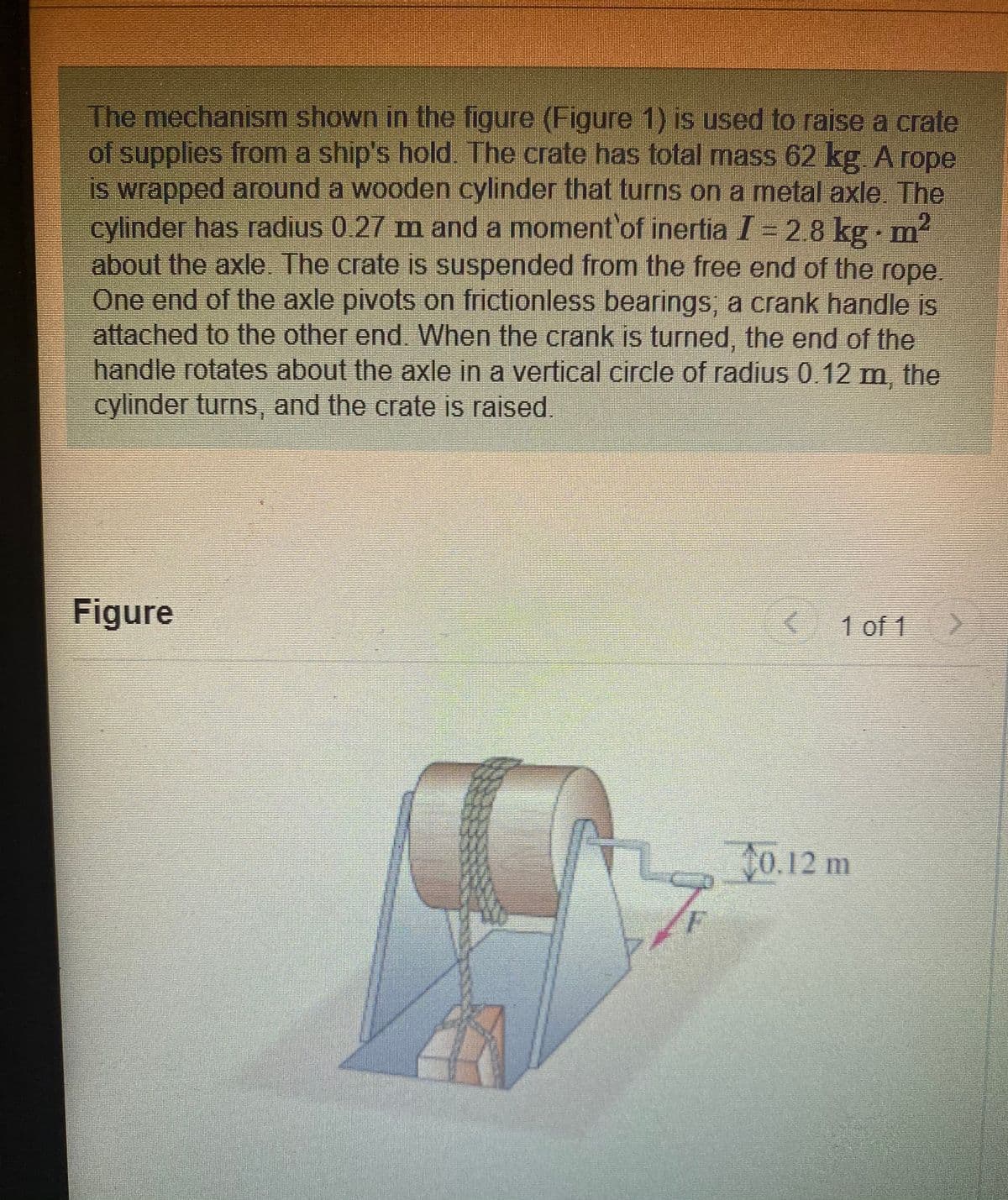The mechanism shown in the figure (Figure 1) is used to raise a crate of supplies from a ship's hold. The crate has total mass 62 kg. A rope is wrapped around a wooden cylinder that turns on a metal axle. The cylinder has radius 0.27 m and a moment'of inertia I = 2.8 kg m2 about the axle. The crate is suspended from the free end of the rope. One end of the axle pivots on frictionless bearings; a crank handle is attached to the other end. When the crank is turned, the end of the handle rotates about the axle in a vertical circle of radius 0.12 m, the cylinder turns, and the crate is raised.
The mechanism shown in the figure (Figure 1) is used to raise a crate of supplies from a ship's hold. The crate has total mass 62 kg. A rope is wrapped around a wooden cylinder that turns on a metal axle. The cylinder has radius 0.27 m and a moment'of inertia I = 2.8 kg m2 about the axle. The crate is suspended from the free end of the rope. One end of the axle pivots on frictionless bearings; a crank handle is attached to the other end. When the crank is turned, the end of the handle rotates about the axle in a vertical circle of radius 0.12 m, the cylinder turns, and the crate is raised.
Mechanics of Materials (MindTap Course List)
9th Edition
ISBN:9781337093347
Author:Barry J. Goodno, James M. Gere
Publisher:Barry J. Goodno, James M. Gere
Chapter1: Tension, Compression, And Shear
Section: Chapter Questions
Problem 1.9.18P: The piston in an engine is attached to a connecting rod AB, which in turn is connected to a crank...
Related questions
Question

Transcribed Image Text:The mechanism shown in the figure (Figure 1) is used to raise a crate
of supplies from a ship's hold. The crate has total mass 62 kg A rope
IS wrapped around a wooden cylinder that turns on a metal axle The
cylinder has radius 0.27 m and a moment'of inertia I = 2.8 kg m2
about the axle The crate is suspended from the free end of the rope
One end of the axle pivots on frictionless bearings, a crank handle is
atlached to the other end. When the crank is turned, the end of the
handle rotates about the axle in a vertical circle of radius 0 12 m the
cylinder turns, and the crate is raised.
Figure
1 of 1
t0.12 m
F

Transcribed Image Text:Part A
What magnitude of the force F applied tangentially to the rotating crank is required to raise the crate with an acceleration of 1.40 mn/s2? (You can ignore the mass of the
rope as well as the moments of inertia of the axle and the crank.)
Express your answer in kilonewtons.
να ΑΣφ
F =
kN
Expert Solution
This question has been solved!
Explore an expertly crafted, step-by-step solution for a thorough understanding of key concepts.
This is a popular solution!
Trending now
This is a popular solution!
Step by step
Solved in 2 steps with 2 images

Knowledge Booster
Learn more about
Need a deep-dive on the concept behind this application? Look no further. Learn more about this topic, mechanical-engineering and related others by exploring similar questions and additional content below.Recommended textbooks for you

Mechanics of Materials (MindTap Course List)
Mechanical Engineering
ISBN:
9781337093347
Author:
Barry J. Goodno, James M. Gere
Publisher:
Cengage Learning

Mechanics of Materials (MindTap Course List)
Mechanical Engineering
ISBN:
9781337093347
Author:
Barry J. Goodno, James M. Gere
Publisher:
Cengage Learning